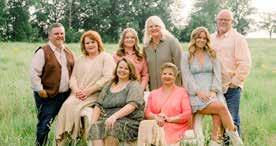




Warnell Family Pharmacy

By Shirley Bloomfield, CEO NTCA–The Rural Broadband Association
In Washington, D.C., we often talk about the new grant programs that are going to help bridge the digital divide in our country. But I want to highlight what I believe has been the most successful rural broadband initiative, the federal Universal Service Fund. So, what is the Universal Service Fund? The Communications Act of 1934 included language that said all Americans should have access to “rapid, efficient, nationwide communications service with adequate facilities at reasonable charges.” Today, the USF is the main federal program helping rural consumers connect to services comparable in price and quality to those in urban areas. This makes services more affordable for low-income families and supports critical connections for schools, libraries and health care facilities in rural communities by offsetting the high cost of building and managing rural communications networks.
There is one big difference that sets the USF apart from many of the new grant programs: The USF not only supports the construction and deployment of networks but also the maintenance of those networks. It helps ensure that these networks are maintained and sustained so Americans continue to make use of broadband long after the last shovel is put down.
An NTCA survey found that without the High-Cost USF program all rural consumers will pay at least $100 more per month for their broadband service. And the viability of some rural broadband networks would be at risk, as the operations costs and repayment of the loans needed to build them cannot be covered.
NTCA is committed to efforts to preserve the USF so that the mission of universal service for all Americans can be fulfilled.
Each month Nielsen, a company that has long tracked viewership habits across a range of media, updates The Gauge. The report offers a snapshot of how various forms of media are consumed to create a picture of the media landscape.
Several key trends shaped the streaming results, such as June marking the end of the school year and start of school breaks, which led viewers 17 and younger to drive the largest upticks in TV usage across all ages.
As a result, this June streaming topped the earlier viewership record set by cable for that month in 2021.



9.9%
8.4% Other streaming: 6% Prime Video: 3.1% Hulu: 3% Disney+: 2% Tubi: 2%
Roku Channel: 1.5% Max: 1.4% Peacock: 1.2%
1.1% Pluto
0.8%
Source: Nielsen The Gauge







About two-thirds of Americans rely on some form of contact lenses or glasses to correct nearsightedness, farsightedness and more. Then there are eye injuries and diseases like glaucoma that can diminish sight, and the inevitable process of aging can also cause a slow decline in eyesight.
In an increasingly online world—where vital information is often communicated using text on screens—people with diminished vision can struggle. However, there are resources available to help those with impaired sight, and even blindness, interact online.
For example, the Americans with Disabilities Act requires all websites to be accessible to everyone. While not every website is ADA compliant, sites for government agencies, banks and larger organizations are. The basic tools you need are free and as handy as web browsers like Chrome, Edge, Firefox and Safari.
BROWSER BY BROWSER
Microsoft’s Edge browser scores well for assistive technologies. It lets users













increase the size of text and get image descriptions for screen readers. Also, a simple keyboard command—Ctrl+Shift+U on PCs and Shift+Command+U on Macs—signals the browser to read the current webpage aloud. Most other browsers require users to go into system preferences or use an extension for screen readers.
Meanwhile, Chrome’s TalkBack screen reader adds spoken, audible or vibration feedback to your device. While the browser does not have a way to change the look of text, it does have extensions that allow users to customize their browsers to control visual clutter.
Google, the maker of Chrome and a popular search engine, has an awardwinning disability employee resource group and says it is committed to hiring employees with disabilities. That commitment also helps it find ways to make its site more accessible.
Like Chrome, Apple’s Safari comes with its own screen reader, VoiceOver. Users can choose the voice they find most pleasing and set the speech speed. It also lets users increase contrast, zoom in and
remove ads and distractions.









Firefox allows users to adjust the settings so every site has the same font, type size and color to enhance the ease of reading. It also has extensions for changing text to speech and making bookmarks larger, among other things.
While users may need a sighted person to set up the assistive features, modern technologies unlock the world to more people than ever.

If you venture into the world of social media—and most people do—you’ll cross paths with personalities known as influencers. From social media platforms like Facebook and X to video sites such as YouTube and TikTok, online personalities have the power to generate attention. With attention comes income, often six figures or more.
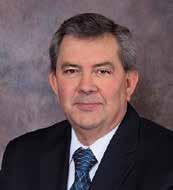
JEFF EATON General Manager
These people, and they can range wildly in accuracy and professionalism, seem to touch on every possible topic: lifestyle, health, politics, sports, entertainment and just about anything else. They can attract millions of eyeballs, and some of the largest, most visible companies advertise on their channels.
I don’t mean to imply this is a new trend. It’s not, at all.
However, as other types of media fall more into the background, online influencers continue to have greater reach and, well, influence. But in our busy and often highly online lives, we shouldn’t lose sight of the other influencers around us. You don’t have to look far, either.
One of the things I enjoy about our community, and this is true of many rural places like ours, is that there are individuals who make a tangible positive difference. They lift others up. They provide help where it’s needed. You need look no further than the pages of this magazine to see stories of neighbors helping neighbors, and what’s more powerful of an influence than that?
You see, every time you smile at someone you pass in the aisle of a store, volunteer with a community organization, help your child with homework or have any of the other interactions that make up daily life, you’re an influencer. This is also something we all can do.
In fact, a commitment to helping others is a core part of our mission at South Central Rural Telecommunications Cooperative. Naturally, it begins with the services we provide—we want our community to have the best communications resources anywhere.
We’ve seen how high-speed internet changes lives, opening doors for local businesses, expanding career options, supporting education and connecting to an exciting world of online resources. We strive to be the people who can answer your questions, solve your communications problems and provide the resources you need today while planning for the future.
But that’s only part of the equation. Every year, SCRTC gives back. One of our guiding principles is that you benefit not only from the services we provide but also through direct contributions of time and money invested into our community.
So, as you enjoy our industry-leading communications services, if there are online influencers you find informative or entertaining, please do enjoy. But I hope you can also join us in finding opportunities to create beneficial, helpful moments right here at home. It’s that spirit of togetherness that makes this place so special.
As always, it’s a pleasure serving you, and I hope SCRTC remains a positive influence in your life.
The SCRTC Community Network is a bimonthly newsletter published by South Central Rural Telecommunications Cooperative © 2024. It is distributed without charge to all customers of the cooperative.
South Central Rural Telecommunications Cooperative is a member-owned corporation dedicated to delivering advanced telecommunications technology to the people of Central Kentucky, including Adair, Allen, Barren, Edmonson, Green, Hart, LaRue, Metcalfe, Monroe, Nelson and Warren counties.
South Central Rural Telecommunications Cooperative, Inc.
1399 Happy Valley Road • P.O. Box 159 Glasgow, KY 42142-0159 270-678-2111 • www.scrtc.com
SCRTC BOARD OF TRUSTEES
Ralph J. Thompson, District I Bonnieville and Munfordville exchanges
Billy Smith, District II Canmer and Horse Cave exchanges
Tim Coomer, District III Cave City and Hiseville exchanges
Ronnie Tucker, District IV Center, Edmonton and Summer Shade exchanges
Kevin Bradshaw, District V Glasgow and Temple Hill exchanges
Zack Kender, District VI Fountain Run, Gamaliel and Lucas exchanges
Anthony Wells, District VII Buffalo and Magnolia exchanges
Jeff Eaton, General Manager
Bobby H. Richardson, Attorney
Produced for SCRTC by:
On the Cover: Brownsville's Warnell Family Pharmacy is a convenient combination of modern medicines and treats for that sweet tooth. See story Page 12.

Story by MATT LEDGER
With cooler days on the horizon, gridiron greatness is just around the corner. Players on all levels from peewee to pro are getting in their workouts and memorizing offensive and defensive schemes, preparing for the season with hopes of playoff glory.
The quarterback is the leader on the field, relying on offensive players to make a connection in the end zone. In the arena of internet connectivity, SCRTC has pro-level routers in our lineup, delivering Wi-Fi signal to the ends of your property. On the receiving end, electronic devices—including cellphones, laptops and tablets—have the latest standards in Wi-Fi technology, making them the best receivers in the game.
“A great quarterback makes a receiver look better, but a great receiver can make a quarterback look better,” says Chuck Jones, an SCRTC network equipment technician and an avid Dallas Cowboys fan. “You really need to have both pieces. It’s a two-way street in technology to complete good reception by the transmitting and receiving antennas.”
Having older devices with outdated technology on a network can degrade the Wi-Fi speed of the entire network. In those cases, the router will revert to legacy standards, which can adversely affect signal strength.
SCRTC technicians test the coverage of each router they install and advise

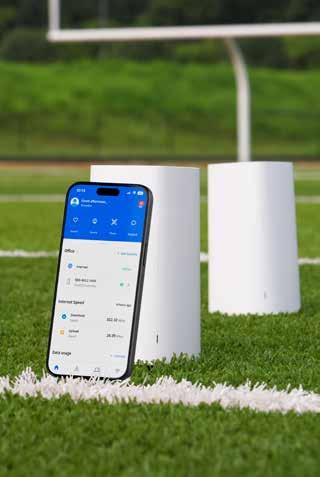
if additional access points are needed.
“Equipment placement within the house is the key starting point,” Chuck says.
When you link these access points wirelessly, that’s considered a “mesh network.” Wirelessly connected networks need to be carefully placed, as the entire network is dependent on the primary router. “Another bonus for the Calix routers is that the installers can use them to troubleshoot issues,” Chuck says. “We are able to see if there is interference and address those issues.”
SCRTC installers prefer to “hardwire” all access points, allowing for the best performance.
TOP: SCRTC’s installers optimize the Wi-Fi signal so that you have coverage throughout your home. The team includes, from left, network equipment technician Chuck Jones, supervisor of broadband plant technicians Chuck Gardner and broadband plant technicians Anthony Graham, Ty McMurtrey and Logan Keith.
LEFT: The Adtran Wi-Fi solution and its intuitive mobile app is a residential system that will keep your network from getting sidelined.
“Just like a football team must have a game plan, we prepare for our clients by understanding their specific needs when we tackle each project by placing game-winning equipment in the field,” Chuck says. “By managing that equipment remotely, SCRTC can ensure the best possible coverage for your home or business.”
The Adtran mesh system offers many benefits:
Wi-Fi 6 technology
• 4 internal antennas for 5 GHz signal
• 2 internal antennas for 2.4 GHz signal
• Fully integrated remote management
• The Intellifi® app offers extensive network stats, speed test results, parental controls, network security and guest access features.
by Matt Ledger
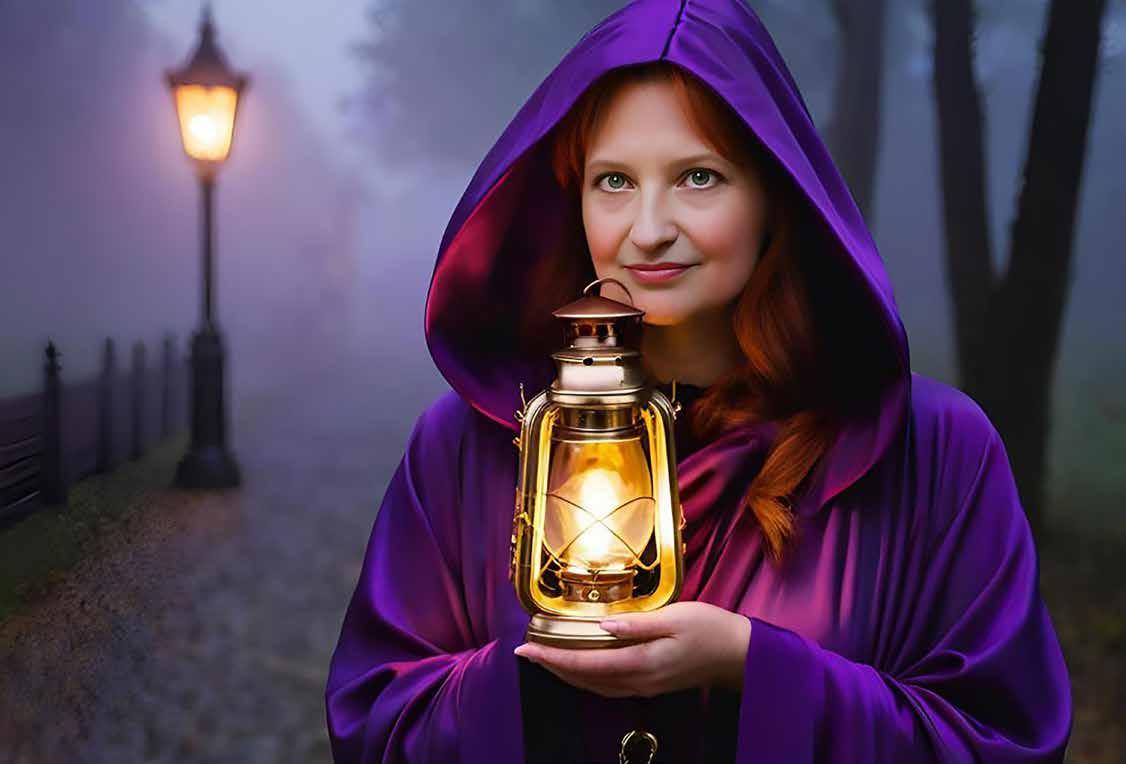
Story by KATIE TEEMS NORRIS
For many, October isn’t complete without spine-tingling ghost stories, and chances are your hometown has a few of its own. Allison Jornlin, co-founder and tour developer with American Ghost Walks, conducts research and writes ghost tour scripts in towns across the United States. Allison is also a paranormal investigator and speaker, and
she’s been featured on the CW Network’s “Mysteries Decoded.”
Ghost tours are immensely popular, and Allison says they can be found in almost every large city and even in many small towns across the country. “I think people have lost their connection with history and with their ancestors, and this is a way to reconnect,” she says.

Unlike haunted house attractions that have terrifying special effects, ghost tours offer authentic history in locations that give guests the chance to literally step into the paranormal. They allow people to connect to the haunted past through walking tours, bus/trolley tours, investigation-style tours and even pub crawls. Some guests report experiencing
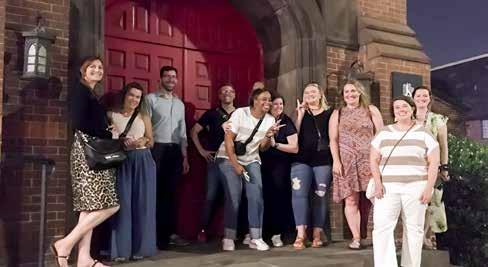
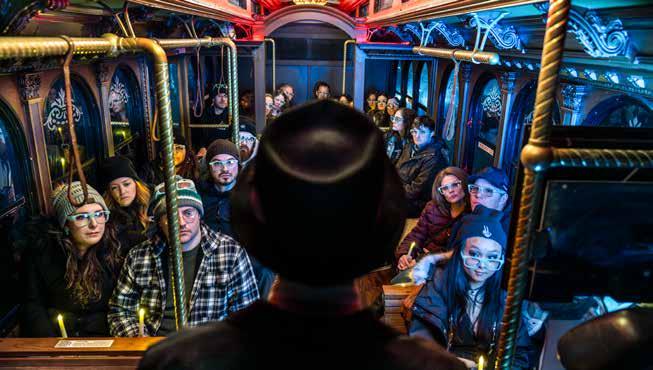
paranormal phenomena, like feeling unexplained cold spots or photographing disembodied faces and shadowy figures.
Allison pores through old newspapers and historical archives and interviews local people to give her tours as much local flavor as possible. “I’m looking for stories that are unique to the community that they come out of,” she says. While many stories across the country have common themes, Allison says, every place is a little bit different.
“You don’t have to believe in ghosts to enjoy the tour,” she says. Skeptics can have fun learning spooky stories. Tour guides often encourage guests to share their personal paranormal experiences to relate to one another. Ghost tours can’t guarantee guests will have an otherworldly encounter, but there is always a possibility.
If you’re ready to test your luck, consider joining these popular local tours, if you dare:
l Charleston, South Carolina’s, rich history, fascinating places, people and landmarks bring with them incredible stories—and lots of ghosts. Check them out through Bulldog Tours. bulldogtours.com/tours/ghost
l The Birmingham Ghost Walk in Alabama includes two walking tours and the Ghosts and Graveyards Chauffeured Experience. bhamhistory.com
l Old Louisville is home to what many consider to be the “most haunted neighborhood in America.” Learn why through Old Louisville Ghost Tours, in Louisville, Kentucky. louisvillehistorictours.com/louisville-ghost-tours
l Most ghost tours in the U.S. run year-round.
l Harpers Ferry, West Virginia, claims to have America’s oldest ghost tour. It began in 1970 and is still running. In 1973, historian Richard Crowe started Chicago’s first ghost tour. He told ghost stories on the radio around Halloween, which inspired Allison Jornlin and her brother to establish American Ghost Walks.
l Many ghost stories have common themes. Allison notes the prevalence of stories about women who met unfortunate ends. Guides across the nation tell local stories of jilted lovers, forlorn widows and vanishing hitchhikers.
Are you spending the spooky season exploring a new town—or your own hometown? A ghost tour is a fun way to learn about the history of a place and its people. Before you book one, follow these tips:
While each tour is unique, they typically fall into these categories: walking tours, bus tours, investigation tours and pub crawls. Investigation tours allow guests to become paranormal researchers for one night, and they typically focus on one building or property. A haunted pub crawl offers spirits of both the alcoholic and ethereal kinds.
Tour companies list important information on their websites, including an overview, length of the tour, walking distance, accessibility, age-appropriateness and cancellation/refund policies. Many tours encourage guests to purchase tickets in advance.
Check Google reviews and websites like Yelp or Tripadvisor for reviews. Search for detailed reviews that weigh the pros and cons of the tour. If you find positive reviews of a specific guide, you may be able to book a tour on a night when that person is working.
If you still have questions after your research, don’t be afraid to give the tour company a call.
Story by PATRICK SMITH
Paychecks aren’t going as far as they used to. Headlines frequently mention rising prices on necessities like fuel, groceries and vehicles— not to mention mortgage rates above 7% and the challenges many people face saving money.
Inflation has made ordinary expenses feel more like discretionary spending for many American families. That’s why Jamie Bewley Byrd created Helping the Hardworking, a nonprofit organization that supports working families with financial assistance to cover expenses during difficult times.
“These are families that work hard to live within their means, and they’re not asking for help,” says Jamie, who started the organization before becoming Barren County Judge/Executive. “They’re working to pay for their health insurance. They’re paying for their groceries. They’re paying for everything, but it’s so hard to make ends meet.”
In 2022, the U.S. Census Bureau noted a median household income of $48,141 in Barren County, compared to the nationwide figure of $74,580. While Kentucky is one of the most affordable states in
America, its residents still face the challenges of lower wages, combined with rising living expenses.
As Christmastime approached in 2019, Jamie, who is raising four young children with her husband, Daniel, recognized the uphill battle many families face to handle holiday expenses. “I have a business, and I saw people coming in who struggled to pay their bills,” says Jamie, who owns Cheerville Athletics and Extreme Gymnastics. “I had a few women who came in and they’d say, ‘Hey, the holidays are really tough. Can I have a few extra weeks?’ I knew there had to be some way to help. Even for people that budget every month, it’s hard because the holidays aren’t typical months. You’re buying gifts, you’re going out to dinners more, you’re traveling to see family. It’s a stressful time.”

people for the extras. Plus, we bought the cards from local businesses, so it helped them out, too. It was a good, combined effort to help the community.”
Helping the Hardworking doesn’t cater to individuals who have recently experienced a job loss, seek funds from other charities or rely on government assistance. “This is more for the people that you don’t always think about as someone who’s struggling,” Jamie says. “We try to cater to people like the single mom who works third shift but never gets to pamper herself and never does anything fun for herself.”
That’s when Helping the Hardworking took off. “I knew there was something we could do for those people,” Jamie says. “I reached out to a couple local people and businesses, and we raised about $2,000 the first year. We gave out gift cards to those
After someone is nominated online, Jamie, along with the organization’s board members, verify
CLOCKWISE: Tickets for Nelly’s show in March 2023 sold out in three hours.
The Thank a Farmer event helps raise funds for local chapters of 4-H and FFA.
The Barrenton, a formal Scottishthemed ball held in May, is a benefit for youth service centers.
Helping the Hardworking hosts some middle school dances, including the Pinks and Polos dance, attended by Shelby Byrd, Landree Button and Haylin Adams.
LEFT: A year after winning “American Idol,” Kentucky native Noah Thompson sold out his Glasgow concert.

and hip-hop artist Nelly, have graced stages in downtown Glasgow, with the concert proceeds helping hardworking community members.
the nominee. “We call every employer to ensure these people are someone who should be nominated,” Jamie says. “These are people who often go unnoticed, and we give them gift cards for dinner or groceries so they can have a little extra. It’s a wonderful feeling to help others and work together as a community, especially for the people who don’t typically ask for help.”
As the nonprofit continues to blossom, it’s grown from giving out gift cards to organizing large fundraising events and activities that attract people from Barren County and beyond. Helping the Hardworking has coordinated everything from large fireworks displays on private land during COVID-19, to middle school dances, free lunches for veterans, first responders, teachers and health care workers, as well as performances by stand-up comedians and concerts.
The events don’t just feature local acts. Nationally known bands like Americana and Old Crow Medicine Show, along with country/pop songwriter Niko Moon, “American Idol” star Noah Thompson
“We don’t really make much of anything on the concerts,” Jamie says. “It’s about bringing new business to the community, and it’s about the convenience of a great show in Glasgow and showing that people don’t have to drive to Nashville or Louisville for a good time. Local businesses, restaurants, Airbnbs, gas stations, they all benefit from hosting big events in our community.”
While Helping the Hardworking has grown well beyond giving people extra money during the holiday season, it’s never wavered from its mission to help the community. “This is a way to help out the people who want to do something special, but they can’t because they’re trying to live within their means,” Jamie says. “When we give the gift cards or whatever we can do to help, and they never expected anything, it’s such an awesome experience for everyone involved. We’re surrounded by wonderful people in our community.”
Visit helpingthehardworking.org, or email helpingthehardworking@gmail.com to nominate an individual or donate. All donations are fully tax deductible and benefit families in Barren County.
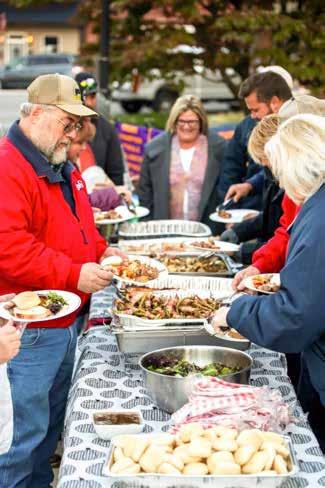
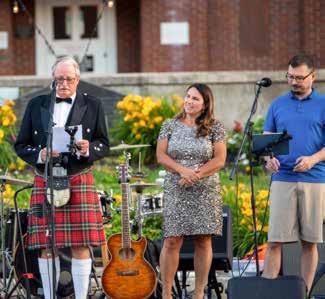


Story by DAVID HERDER and DREW WOOLEY
For much of her life, Olivia Murphy focused on becoming a collegiate swimmer. The biggest obstacle she faced didn’t come in the pool—it was catching the eye of college coaches.
Each year thousands of student-athletes pursue college athletic scholarships. Ultimately, only about one out of every 50 succeeds, according to a 2021 study by Next College Student Athlete. That bar can be even tougher to clear for athletes like Olivia, who live in rural areas, where it’s often difficult to get the attention of major programs.
For those students, earning a spot on a college roster takes more than just the talent and commitment to be a high-level athlete—it also takes a “second job” as a communicator and organizer, working just to be seen.
“I didn't start the actual recruitment process until summer of my junior year, which is a little late for some people,” says Olivia, a Tennessee resident and 2024 Tullahoma High School graduate.
Olivia’s path was more straightforward than that of many other athletes: Swim fast, win races. A key member of the Wildcats’ school-record-setting relay team, she recorded plenty of fast times while helping the team win its first division title.
She knew she had the speed, she just needed the coaches to know it, too. “When you first reach out to a coach, whether it’s through a questionnaire or an email, you put your best events and your best times in there,” Olivia says.
When prospective recruits submit statistics, coaches compare their times to those of their current swimmers, as well as the
ones winning division and national titles. Athletes from almost every sport send out these cold-call emails to coaches across the country. In sports like football and basketball, where skills can’t be boiled down to a set of times or statistics, athletes will create their own highlight videos and send those to coaches.
This can be especially valuable for rural athletes. Coaches can’t visit every town to scout athletes, but there’s no travel time in opening an email. Olivia says coaches especially want to see the swimmers’ videos. “They love videos,” she says. “Most coaches like to see video because they want to see your technique or where your weaknesses might be.”
Sometimes, rather than sending videos, recruits travel to camps and showcases so coaches can watch them in action and compare their skills to athletes at a similar level. These are often sport-specific camps run by college programs where potential recruits get hands-on practice time with
by
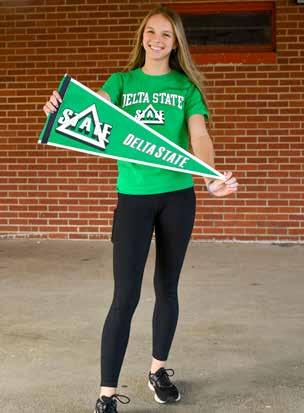

coaches. At regional showcases or tournaments, thousands of athletes can test their skills while scores of coaches look for diamonds in the rough.
Landyn Cox, a 2024 high school graduate from McKee, Kentucky, competes in archery and found success at these large events since most high schools don’t have archery teams. He was offered a scholarship to be an archer at the University of the Cumberlands in Williamsburg, Kentucky. He competed on the USA Archery U18 Compound National Team, the World Archery 3D Championships and other USA Archery Team events. He says the USAT events are a solid way to draw attention. “If you win like one of the USATs or certain big events, that gets your name out there pretty fast,” he says.
Once coaches begin recruiting, the challenge comes in settling on a school. Olivia narrowed down her list to three. “I wanted to limit myself to three visits because I’m really bad at decisions,” she says.
Part of the process was deciding what size school she wanted to attend. Many athletes feel the need to compete at a prestigious NCAA Division 1 school, but they
1. Know your skill level and learn the NCAA or NAIA eligibility requirements.
2. Compile an athletic resume with:
l Skills video
l Athletic stats
l Academic transcripts, ACT/SAT scores
l Extracurricular activities
3. Email coaches.
l Include your athletic resume.
l Subject line: Name, position, current grade level and key stat: “Jane Doe, High School Sophomore, Pitcher, 90 mph fastball”
l Individually craft each email, clearly stating why you’re interested in that program.
4. Make campus visits and meet coaches. Keep sending updated stats.
5. Lock down your offer and negotiate your amount. Don’t discount merit-based, academic or other scholarships.
could find a home—and potentially more playing time or better financial aid—at a smaller school. “Division 1 isn’t everything,” Olivia says. “It’s not live or die.”
No matter the size or program, a visit is the critical component. After a successful recruiting visit where she got along great with her future teammates, Olivia chose Delta State University, a Division II school in Cleveland, Mississippi.
“They need to go where they feel like they best fit,” she says. “I was like,
‘There’s no way that I’m not going to go Division 1,’ and then I found a school that matches up with Division 1 schools and I got better scholarship offers and felt like I fit with the team better. And so, I was like, ‘Oh, that’s not the end of the world.’”
But it will be a whole new world for Olivia, Landyn and other rural athletes as they aim to parlay their hometown successes and hard work to the next level.
Story by JOHN CLAYTON
us

The milkshakes are served cold in tall glasses, while the soda jerks and other servers at Warnell Family Pharmacy & Soda Shoppe sport bow ties and warm smiles.
The old-fashioned soda fountain in a modern family-owned pharmacy is the vision of the husband-wife team of Samuel and Valerie Warnell. They combine nostalgia with 21st-century convenience in downtown Brownsville.
Samuel describes the dream of opening a drugstore and soda fountain in his hometown as “neat,” as if he himself comes from an era when Chevys had fins, hep cats said “daddy-o” and Elvis was king.
“Local pharmacies were the go-to source for everything when I was growing up here,” Samuel says. “It had everything from the soda fountain, food and medications to simple socialization. It’s always been a hub for the community.”
That’s exactly what Samuel and Valerie had in mind when they opened in 2023. Despite its throwback feel, their dream boasts all the 21st century touches. There is a mobile app and portal on the pharmacy website for ordering and managing accounts. That’s coupled with deliveries and, of course, breakfast, lunch, coffee and dessert at the soda shop.
Samuel credits the arrival of SCRTC’s high-speed internet service for allowing his business and customers to use that
technology, calling it a game changer for the entire area.
“There are many things that we do that are very different than how it used to be,” Samuel says. “So, we wanted to have that technology built in because we wanted to be very approachable to our young families and young people but also bring back a lot of those good memories for the generation that is just ahead of us that still remembers those small-town soda fountains and drugstores that had a big impact on everybody’s lives.”
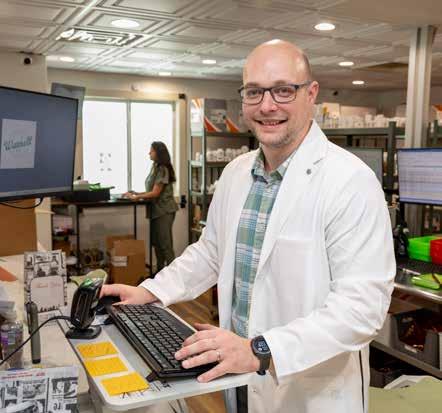
The soda shop menu is also a mix of old and new—traditional sundaes and sandwiches, along with salads, coffees and other items that skew toward modern taste buds.
“We kind of have a little bit of everything,” Valerie says. “We’ve got sandwiches and salads and the banana splits and the egg creams and the chocolate sodas, but added some of the more updated things like macchiatos and lattes or things like that to give everybody something that they would like.”
Valerie also says the reception the pharmacy received from the local community and surrounding area has been everything she and Samuel hoped
FROM TOP: Kaitlin Stivers prepares an old-fashioned soda.
Pharmacist Samuel Warnell owns the business.
by

Chocolate sodas are a popular treat at Warnell’s Family Pharmacy.
for when they took the chance on their old-fashioned dream.
“I heard an old pharmacist say one time if you take care of the community, then they’ll take care of you,” Samuel says. “And I found that to be true.”
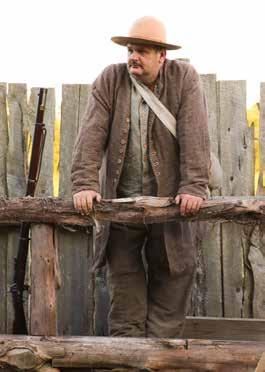

Story by MATT LEDGER
Along gravel road meanders through rolling fields along Rushing Island Bend Road in Horse Cave, heading north toward the Green River. It traverses an 84-acre property owned by the Hart County Historical Society, now known as the Battle for the Bridge Preserve, which is listed on the National Register of Historic Places.

Kentucky was a neutral state during the Civil War, with sympathizers on both sides. “The Bluegrass state became a gateway for the Federal Army to maneuver into Southern states, transporting much-needed supplies and men to Federal troops,” says Greg Ard, the transportation director for Hart County Schools and executive director of the Woodson House and Battle for the Bridge Preserve. “The railroad was the lifeline back then.”
In December 1861, Brig. Gen. Alexander McCook moved the 2nd Division to Nolin, Kentucky, and Camp Wood. On the southern side of the Green River, Confederate forces continued to hold defensive lines. On Dec. 10 the Confederates destroyed two columns of the L&N rail line to disrupt the Federal supply line of men, munitions and other supplies.
“For the Federal Army and Lincoln, losing the bridge would cause the Army to divert to the roads and rivers, which would be slower in transporting men and supplies when time was of the essence,” Greg says.
A few companies from the 32nd Indiana Volunteer Infantry Regiment crossed the river and began building a pontoon bridge to span the gap. Construction took only a week.
Over 500 Union troops advanced to clash with about 1,350 Confederates during the Battle of Rowlett’s Station. The skirmish
on Dec. 17, 1861, was considered inconclusive by historians, though both sides claimed victory.
On Sept. 14, 1862, 4,000 Federal forces under Col. John T. Wilder squared off against 2,000 Confederates on the first day of what came to be known as the Battle for Munfordville. Rebel forces continued arriving the following day, growing the force strength to massively outnumber the Union troops. “Another advantage that the Confederates had was that Brig. Gen. Simon Bolivar Buckner was from Hart County,” Greg says. “He knew the entire area and had hometown information that no one else did.
“Wilder quickly realized that fighting is futile,” Greg adds. “He then did something you don’t generally hear in warfare, asking Buckner what he should do.”
Under a flag of truce, the Union commander was escorted to Buckner’s headquarters, where the Confederate general gave him a tour, showing him what he was up against. Wilder surrendered the following morning, Sept. 17.
The bridge stands today as a reminder of the battles where both Civil War rivals claimed victory and another that ended under the truce.
The Battle for the Bridge Preserve will host the annual Hart County Civil War Days, Sept. 13-15.
Visit the Hart County Historical Museum’s Facebook page for the full schedule of events. hartcountykycivilwardays.com battlefields.org/learn/civil-war/battles/munfordville hartcountymuseum.org

It’s time to think about tailgating. Even if you aren’t a football fan, you can enjoy the food that goes along with the big game, from pots of chili to tater skins and Buffalo wings.
But these tailgating treats may not agree with your waistline. There are healthy alternatives to consider for lightening up your football spread without sacrificing taste. You’ll score some touchdowns yourself.

Food Editor Anne P. Braly is a native of Chattanooga, Tennessee.
Photography by Mark Gilliland
Food Styling by Rhonda Gilliland
4 boneless chicken breasts (2 to 2 1/2 pounds)
1 teaspoon dried basil
1 teaspoon salt
1 teaspoon onion powder
1/2 teaspoon garlic powder
1 teaspoon dried thyme
1 teaspoon dried parsley
1 tablespoon butter
2 tablespoons olive oil
1 large onion, chopped
3 stalks celery, chopped
3/4 cup chopped red bell pepper
2 cans whole green chilies, chopped (see tip)
3-4 cans cannellini beans, drained and rinsed (see note)
2-3 teaspoons cumin
1 cup sour cream
1/2 cup heavy cream
1/2-1 cup chopped fresh cilantro
1/2-1 cup grated Monterey Jack cheese
Additional chicken broth, if needed
In large pot, add chicken breasts and completely cover with water (4-6 cups).
Simmer chicken breasts with basil, salt, onion powder, garlic powder, thyme and parsley until completely cooked.
Remove chicken from broth and let cool. Reserve the seasoned broth for the chili. Once chicken is cool, chop and set aside. In a large stock pot, add butter and olive oil, and saute onion, celery and bell pepper until vegetables are translucent. Add chopped chilies and two cans cannellini beans. When mixture is warm, mash beans with a potato masher. Add 2-3 cups of the reserved broth, chopped chicken, cumin and 1-2 more cans cannellini beans. Let simmer 30 minutes to an hour. If mixture becomes too thick, add more broth. Add sour cream, heavy cream and fresh cilantro, and stir well. Taste and adjust seasonings, such as salt and cumin. Just before serving, stir in grated Monterey Jack cheese and ladle into serving bowls.
Tip: You will get better quality if you buy the whole chilies rather than chopped chilies.
Note: Progresso brand provides a better-quality bean that holds up well as the chili simmers, and you should only need three cans. If you use another brand and find that it is disintegrating as the chili simmers, add a fourth can of beans.

These delicious wings are oven-baked.
1/2 cup all-purpose flour
2 tablespoons garlic powder
2 teaspoons ground pepper
3 large eggs, beaten
1 1/2 cups panko breadcrumbs
1 1/4 cups grated parmesan cheese
2 pounds chicken wings, cut at joints, wing tips discarded
3 tablespoons balsamic glaze (storebought or made from scratch)
Lemon wedges
Ranch dressing
Celery and carrot sticks
Preheat oven to 450 F. Line a baking sheet with parchment paper. Coat with cooking spray. Combine flour, garlic powder and pepper in a shallow dish.
This recipe from Eating Well could be the creamiest hummus you’ve ever tasted. It’s best made a day in advance.
8 ounces dried chickpeas (about 1 cup)
1 tablespoon baking soda
7 large cloves garlic, divided 1/2 cup extra-virgin olive oil, divided 1/2 cup tahini, divided
1/4 cup fresh lemon juice plus 1 tablespoon, divided
1 1/2 teaspoons kosher salt
1/4 teaspoon ground cumin, plus more for garnish
Paprika for garnish
1/4 cup chopped flat-leaf parsley
Place chickpeas in a medium saucepan and cover with 2 inches of water. Stir in baking soda. Soak overnight. Drain the chickpeas and rinse well. Rinse out the pan. Return the chickpeas to the pan and cover with 2 inches of fresh water. Add garlic. Bring to a boil. Keep at a rolling boil until the chickpeas are tender and almost falling apart, 25-40 minutes.
Reserve about 3/4 cup of the cooking water, then drain the chickpeas. Set aside
2 tablespoons of the prettiest chickpeas for garnish. Rinse the remaining chickpeas and garlic and set the colander over a bowl. Refrigerate the chickpea mixture, reserved cooking water and pretty chickpeas separately overnight.
The next day, combine the chickpeas, 6 of the garlic cloves and 1/2 cup of the reserved cooking water in a food processor (or blender) with 1/4 cup each oil, tahini and lemon juice. Add salt and cumin. Process until creamy. Transfer to a serving bowl. Puree the remaining 1/4 cup each oil and tahini with the remaining garlic clove, 2 tablespoons of the cooking water and 1 tablespoon lemon juice until smooth.
Make an indention in the center of the hummus and spoon in the tahini-lemon mixture. Sprinkle the hummus with cumin and paprika, if desired. Garnish with the reserved whole chickpeas and parsley. Serve with fresh carrots, celery and other colorful vegetables and/or pita chips.
Place eggs in a second shallow dish. Combine panko and cheese in a third shallow dish. Working in batches, dredge chicken pieces in the flour mixture, then the eggs and finally in the panko mixture, shaking off excess after each dredging. Place on the prepared baking sheet. Coat the chicken lightly with cooking spray. Bake, turning the chicken halfway through, until the chicken is golden brown, and an instant-read thermometer inserted in the thickest portion registers 165 F, 20-25 minutes.
Arrange the chicken on a platter. Drizzle with balsamic glaze and serve with lemon wedges and ranch dressing for dipping with celery and carrots.


DOORS OPEN FOR REGISTRATION AT 6 P.M.
ELECTION RESULTS WILL BE ANNOUNCED FOR: DISTRICT IV: SUMMER SHADE, EDMONTON, AND CENTER DISTRICT VII: MAGNOLIA AND BUFFALO The Spirituals will perform at this year’s annual meeting. The family band has been performing for 48 years. Check them out on Facebook @thespirituals.
